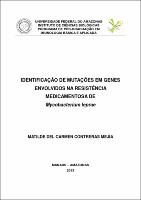| ???jsp.display-item.social.title??? |


|
Please use this identifier to cite or link to this item:
https://tede.ufam.edu.br/handle/tede/5195| ???metadata.dc.type???: | Dissertação |
| Title: | Identificação de mutações em genes envolvidos na resistência medicamentosa de Mycobacterium Leprae |
| ???metadata.dc.creator???: | Contreras Mejía, Matilde del Carmen  |
| ???metadata.dc.contributor.advisor1???: | Paula, Lúcia de |
| ???metadata.dc.description.resumo???: | A hanseníase é uma doença infecciosa crônica causada pelo Mycobacterium leprae. Os esforços globais no controle da hanseníase incluindo a poliquimioterapia (PQT) que consiste na combinação dos fármacos: rifampicina, dapsona e clofazimina têm levado à significativa redução na detecção de casos novos nos últimos anos. A atual estratégia para o controle da hanseníase está embasada principalmente na PQT e pretende prevenir o surgimento, a transmissão e a disseminação de cepas resistentes de M. leprae. Atualmente, sabe-se que mutações no gene folp1 de M. leprae resultam em resistência à dapsona. Mutações no gene rpoB são responsáveis pela resistência à rifampicina. Mutações no gene gyrA são correlacionadas com resistência às fluoroquinolonas. O objetivo deste estudo foi identificar mutações nos genes folp1, gyrA e rpoB do M. leprae de pacientes com hanseníase atendidos no centro de referência de doenças dermatológicas no estado do Amazonas, Brasil. Neste trabalho foram utilizadas técnicas da Biologia Molecular incluindo Reação em Cadeia da Polimerase (PCR), Leprosy Drug Suceptibility-DNA microarray (LSD-DA) e sequenciamento de DNA. Com o LSD-DA foram identificadas duas mutações no gene rpoB em dois diferentes amostras. Através do sequenciamento de DNA foram detectadas quatro mutações no gene folp1, cinco mutações no gene gyrA e seis mutações no gene rpoB. Nestes dados incluem-se duas amostras com mutações nos genes gyrA e rpoB, indicando multidroga resistência. Resistência primaria e secundária foi confirmada usando LDS-DA e sequenciamento de DNA em amostras de raspados dérmicos de pacientes com hanseníase, mostrando a disseminação de cepas resistentes de M. leprae nesta área do Brasil e a importância de avaliar o tratamento nestes pacientes para prevenir a disseminação de bacilos resistentes na hanseníase. |
| Abstract: | Leprosy is a chronic infectious disease caused by Mycobacterium leprae. Worldwide efforts to control leprosy with multidrug therapy (MDT), which is a combination of the drugs rifampin, dapsone and clofazimine, have led to a significant reduction in the detection of new cases in recent years. The current control measure for treating leprosy based mainly in MDT is designed to prevent the emergence, transmission and spread of resistant strains of M. leprae. Although resistance has been reported since 1964 to dapsone, since 1976 to rifampin and since 1994 to ofloxacin, determining the prevalence of drug resistance was made possible only with the advent of molecular biology techniques. It is known that mutations in the folp1 gene result in dapsone resistance. Mutations in the rpoB gene are responsible for rifampin resistance. Mutations in the gyrA gene are associated with fluoroquinolone resistance. The aim of this study was to identify mutations in the folp1, gyrA and rpoB genes of M. leprae from leprosy patients being treated at a reference center of dermatologic diseases in the state of Amazonas, Brazil. We utilized molecular biology techniques including conventional Polymerase Chain Reaction (PCR), Leprosy Drug Susceptibility-DNA microarray (LDS-DA) and DNA sequencing. Using the LDS-DA test two mutations in the rpoB gene were observed in two different samples. These mutations were confirmed by DNA sequencing. Through DNA sequencing four mutations in the folp1 gene five mutations in the gyrA gene and six mutations in the rpoB gene were detected. This included two samples that had mutations in both the gyrA and rpoB genes, indicating multidrug resistance (MDR). Primary and secondary drug resistance was confirmed using LDS-DA analysis and DNA sequencing in slit skin smear specimens obtained from leprosy patients, showing the spread of resistant strains of M. leprae in this area of Brazil and the importance to vary the treatment in these leprosy patients to prevent the dissemination of resistant leprosy bacilli. |
| Keywords: | Hanseníase Mycobacterium leprae Mutações Poliquimioterapia Leprosy Mycobacterium leprae Resistant Mutations Multigrug therapy |
| ???metadata.dc.subject.cnpq???: | CIÊNCIAS BIOLÓGICAS: IMUNOLOGIA |
| Language: | por |
| ???metadata.dc.publisher.country???: | Brasil |
| Publisher: | Universidade Federal do Amazonas |
| ???metadata.dc.publisher.initials???: | UFAM |
| ???metadata.dc.publisher.department???: | Instituto de Ciências Biológicas |
| ???metadata.dc.publisher.program???: | Programa de Pós-graduação em Imunologia Básica e Aplicada |
| Citation: | CONTRERAS MEJÍA, Mtilde del Carmen. Identificação de mutações em genes envolvidos na resistência medicamentosa de Mycobacterium Leprae. 2013. 78 f. Dissertação (Metrado em Imunologia Básica e Aplicada) - Universidade Federal do Amazonas, Manaus, 2013. |
| ???metadata.dc.rights???: | Acesso Aberto |
| URI: | http://tede.ufam.edu.br/handle/tede/5195 |
| Issue Date: | 17-May-2013 |
| Appears in Collections: | Mestrado em Imunologia Básica e Aplicada |
Files in This Item:
| File | Description | Size | Format | |
|---|---|---|---|---|
| Dissertação Matilde Contreras.pdf | Reprodução Total Autorizada | 2.23 MB | Adobe PDF |  Download/Open Preview |
Items in DSpace are protected by copyright, with all rights reserved, unless otherwise indicated.




